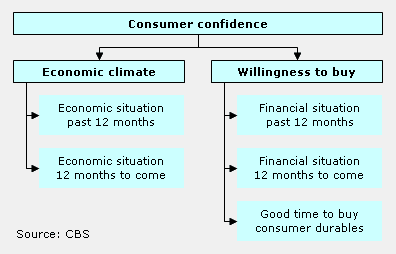most substantial increase consumer spending in four years, consumer confidence marginally down

According to figures released by Statistics Netherlands today, Dutch consumer spending on goods and services was 2.4 percent up in February 2015 from the same month last year, i.e. the most substantial increase in four years. Consumers spent more on natural gas, clothes and home furnishing articles. April’s consumer confidence index declined marginally relative to March.
Consumption figures have been adjusted for price changes and differences in the shopping-day pattern.
Dutch consumers spent more on natural gas, clothes and home furnishing articles
Because temperatures were lower in February 2015 than in February 2014, consumers used more natural gas than one year previously. Partly because of this, spending on other goods, including energy, was up by 7.2 percent. Household spending on durable goods was 4.1 percent higher than twelve months previously. Consumers spent more on clothes and home furnishing articles. Last Wednesday, Statistics Netherlands already reported that - for the first time in six months - clothing shops achieved turnover growth in February compared to February 2014.
Dutch consumers spent 1.8 percent more on food, drinks and tobacco products than last year. Household spending on services - accounting for more than half of total domestic consumer spending - grew by 1.0 percent. Services include rent, public transport, visits to restaurants or hairdressers, telephone services and insurance premiums.
Circumstances for consumption improve further in April
According to Statistics Netherlands’ Household Consumption Radar, circumstances for Dutch household consumption improved further in April relative to one month previously. Dutch manufacturers were much more optimistic about future employment in their sector. On an annual basis, house prices (excluding new constructions) and share and bond prices also rose more rapidly, but consumers were a bit more negative about future employment. By means of six indicators, the Household Consumption Radar shows whether circumstances for Dutch consumption have improved or become less favourable.
Consumer confidence slightly down
The mood among consumers has declined slightly in April 2015 compared to March. Consumer confidence fell by 2 points to 0 in April. This means that there are as many optimists as pessimists among Dutch consumers in April. The marginal decrease is caused by the fact that consumers are less optimistic about the economy. Consumers’ willingness-to-buy also deteriorated somewhat.
Consumer confidence fell to 0 in April, which is far above its long-term average over the past two decades (- 8). The lowest level was reached in February 2013 when consumer confidence dipped to - 44.
Consumers less optimistic about the economic climate, willingness-to-buy in decline
Consumers are less optimistic about the economy in April than they were in March. The component indicator Economic climate fell from 15 in March to 12 in April, because consumers were less positive about the economic situation in the next and past 12 months. Consumers’ willingness-to-buy, a component indicator of consumer confidence was - 8 in April, versus - 7 in March.
Consumer confidence
Consumer confidence

Source, StatLine:
For more information on economic indicators, see the Economic Monitor.